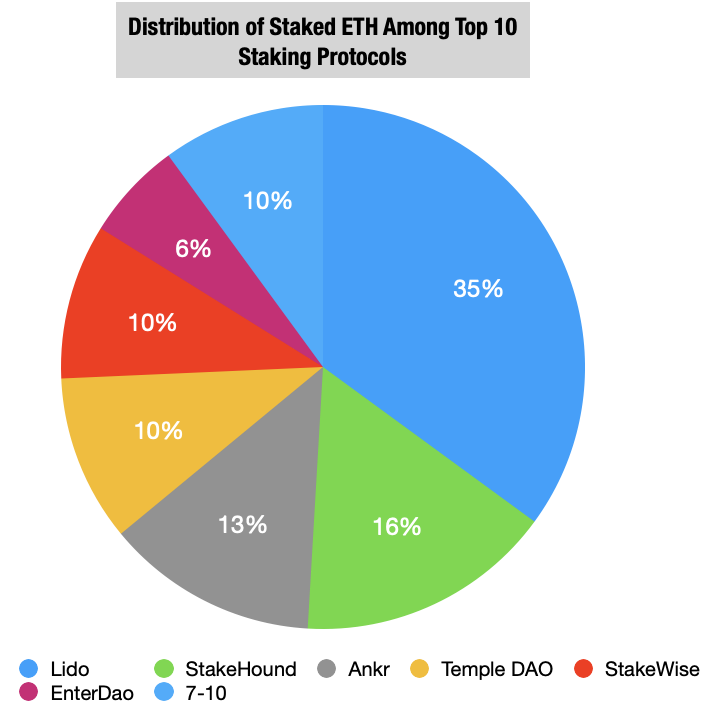Decentralized finance (DeFi) has revolutionized the crypto market but is also making its mark on the global economy. There are many ways to earn a passive income through various decentralized protocols. One of the most profitable means that most DeFi users consider is earning via staking. Proof-of-stake blockchains like Ethereum are secured through staking protocols, allowing network participants to run validator nodes using their staking funds. Yet, the main challenge in traditional staking is that the staked tokens cannot be transacted or used as collateral to earn more yield across other DeFi ecosystems. Liquid staking aims to solve this liquidity issue by providing additional token minting representing a staked asset.
How does this work exactly? This guide dives into liquid staking and its benefits for current DeFi users. We also go over how liquid staking differs from other staking methods.
What is liquid staking?

Liquid staking is a staking solution that enables users to access liquidity while also staking their tokens. This means you can contribute to a proof-of-stake (PoS) blockchain as you would with traditional staking. However, instead of being limited by bonding periods, you receive a “receipt” of your staked funds as a liquid staking token, or LST. This LST receipt can be used in other DeFi systems to generate additional yield and reward opportunities. In other words, this type of staking involves storing your funds in DeFi escrow accounts. Users can still access their funds during the staking period, which makes the protocol liquid or “fluid.”
To date, the liquid staking market and LSDs (liquid staking derivatives) are on the rise. On June 16, 2023, Binance Research published a report highlighting newer DeFi protocols built on LSD and older DeFi protocols.
“LSDfi protocols have experienced a rapid increase in total value locked (TVL) over the past few months, benefiting from the adoption of liquid staking. As the narrative gained steam, cumulative TVL in top LSDfi protocols crossed the US$400M mark and has more than doubled since a month ago.”
Binance Research
How does liquid staking work?
Just as in traditional proof-of-stake protocols, liquid staking works by depositing funds into an escrow account which is run by a smart contract. The platform issues tokenized versions of the staked funds in return. These tokenized versions are worth the equivalent value in return.
Keep in mind that you still earn the rewards from your staked funds, but in liquid staking, you can now use those tokens for other purposes. These liquid staking tokens (LST) can then be transferred out of the platform, stored in another place, traded, or spent without it impacting the initial deposit. Now to gain access to your original holding, you will need to exchange back the tokenized versions of the same value.
Below is a liquid staking protocol chart that also shows how LSTs can be used in external DeFi projects.

What is the difference between staking and liquid staking?
Traditional staking requires you to deposit your funds into a smart-contract-operated escrow account for some time. Depending on the selected plan, this locking period can range from days to months. During this time, investors cannot touch their funds.
Conversely, when investors stake their funds using a liquid staking service, these funds are not locked. Token holders receive the receipt token as evidence of their stake ownership. So the primary difference is that with liquid staking, you have full access to your funds at all times and unstake at any time without any effects. As a result, this equates to higher rewards and greater market liquidity.
Benefits of liquid staking
The most obvious benefit that liquid staking provides is the additional reward opportunities for its users. This method allows you to earn staking rewards without getting them locked. However, for additional rewards, you can diversify your yield opportunities by applying LST in various protocols, such as lending pools and prediction markets. As opposed to tokens staked on the Ethereum network, for example, liquid tokens can be traded and used as collateral. In addition, you can unstake at any time.

Do bear in mind that liquid staking is not without risk. Below we go over the common pros and cons when it comes to this type of investment.
Liquid staking pros and cons
Pros
- Unlocked liquidity: Liquid staking does not lock tokens that can be unstaked at any given time. In addition, liquid staking tokens can be used as collateral.
- Yield-farming: LST can be used on other DeFi protocols to participate in various yield farming. This increases the chances of receiving more rewards.
- Crypto-backed loans: Investors can use existing crypto assets in exchange for a crypto-backed loan by locking up funds and receiving tokenized liquid versions of their assets.
Cons
- Requires technical expertise: Those new to DeFi (particularly staking protocols) may not have the technical expertise to engage in the platforms on their own.
- Smart contract risks: Liquid staking relies on smart contract operability, but smart contracts always run the risk of bugs or attacks.
- Price depegging: The price of LSTs is not pegged to the underlying asset they represent and can drop below the asset’s price due to unexpected market volatility.
Liquid staking services
The market is full of liquid staking protocols offering multiple services, with numbers steadily increasing. For example, specific blockchains offer their own protocols by default. Yet, other blockchains like Solana (SOL) and Polkadot (DOT) rely on third-party facilitation with liquid staking. Below, you can see the TVL rankings per each of these platforms.

Lido
The Lido Finance protocol was launched in 2020 and is overall the best and most well-known platform for liquid staking. The project started as a viable staking solution specifically for the Ethereum network. Since then, it has expanded its capabilities to other ecosystems such as Polygon, Solana, and Kusama (KSM).
Did you know? Lido also runs a decentralized autonomous organization (DAO) using its native network token LDO. These tokens allow users to vote on network proposals and potentially see growth from their assets through staking.
Upon depositing their stakes funds, users receive derivatives in the form of “st” (such as stETH) and the name of the asset ticker. These can then be withdrawn to use in more than 27 DeFi applications and crypto wallets. Staking rewards on Lido range from 4.8% to 15.5%, and for its liquid staking services, Lido charges a 10% fee.

Rocket Pool
A great alternative to Lido is Rocket Pool which is a decentralized platform used to stake ethereum. Rocket Pool launched in 2016, enabling users to stake and run a permissionless node. This feature allows you to stake with less than 32 ETH, however, while earning staking rewards up to 8.98% APR along with RPL collateral for securing the platform. Alternatively, you can use its liquid staking services to stake ETH and receive rETH liquid tokens with up to 3.15% APR (based on a 7-day average).

OKTC
The OKX platform offers a liquid staking service in order to stake and earn OKT on the OKT Chain. In return for staking OKT, users receive staked OKT (stOKT). This is a versatile KIP-20 token that can be traded and utilized within the OKTC protocol. The value of the token is subject to change over time because the staking funds received from staking OKT are not constant.
The OKT unstaking period is set to a 14-day cycle, and the staked OKT on OKT liquid staking will not only generate earnings, but these earnings will generate its own earnings as well (compound earnings). In addition, you can even earn swap fees just for providing liquidity to the platform’s OKTC Swap feature.

Hubble
The Hubble protocol enables borrowing against staked crypto assets on its liquid platform. It first became popular after participating in the Solana hackathon, but what makes this platform stand out is its borrowing services. This protocol allows investors to borrow against their crypto and use the borrowed tokens as collateral in other DeFi platforms.
The USDH stablecoin is used for the platform’s crypto loan services. You can mint USDH against multiple types of collateral and repay whenever you want. This means Hubble supports multiple assets and lets you deposit from different networks, which provide up to 11x leverage on collateral.

Is liquid staking risky?
As with any form of financial protocol involving crypto, there will always be risks. Yield farming poses a risk of liquidation. If the market takes a downturn, the asset value may drop below the requirements for collateralization. Another major risk associated with liquid staking is smart contract security.
Generally, smart contracts are vulnerable to attacks and bugs. To mitigate this, protocols and smart contracts need to be regularly audited. As per the price of the token, there is also a risk of depegging. However, with good risk management and an investment strategy, you can substantially lower your odds of making mistakes or being on the losing end.
Liquid staking and the future of DeFi
Liquid staking offers more benefits to its users than traditional staking protocols. Investors no longer need to wait until their lock period ends to access their funds. Apart from being more convenient, rewards are also doubled. Users still earn yield from their staked funds as normal; however, with the introduction of liquid staking tokens, users can receive an additional yield while these tokens go to work on other DeFi networks. And since users can unstake when they wish, this makes it attractive to a wider share of investors.
With all that said, it will be of little surprise to see liquid staking protocols far outperform traditional staking services in the future.
Frequently asked questions
What is an example of liquid staking?
Is liquid staking good?
What is the highest liquidity in crypto?
How big is the staking market?
What is the top liquid staking protocol?
What is the difference between adding liquidity and staking?
What is liquid stacking protocol?
Disclaimer
In line with the Trust Project guidelines, the educational content on this website is offered in good faith and for general information purposes only. BeInCrypto prioritizes providing high-quality information, taking the time to research and create informative content for readers. While partners may reward the company with commissions for placements in articles, these commissions do not influence the unbiased, honest, and helpful content creation process. Any action taken by the reader based on this information is strictly at their own risk. Please note that our Terms and Conditions, Privacy Policy, and Disclaimers have been updated.




